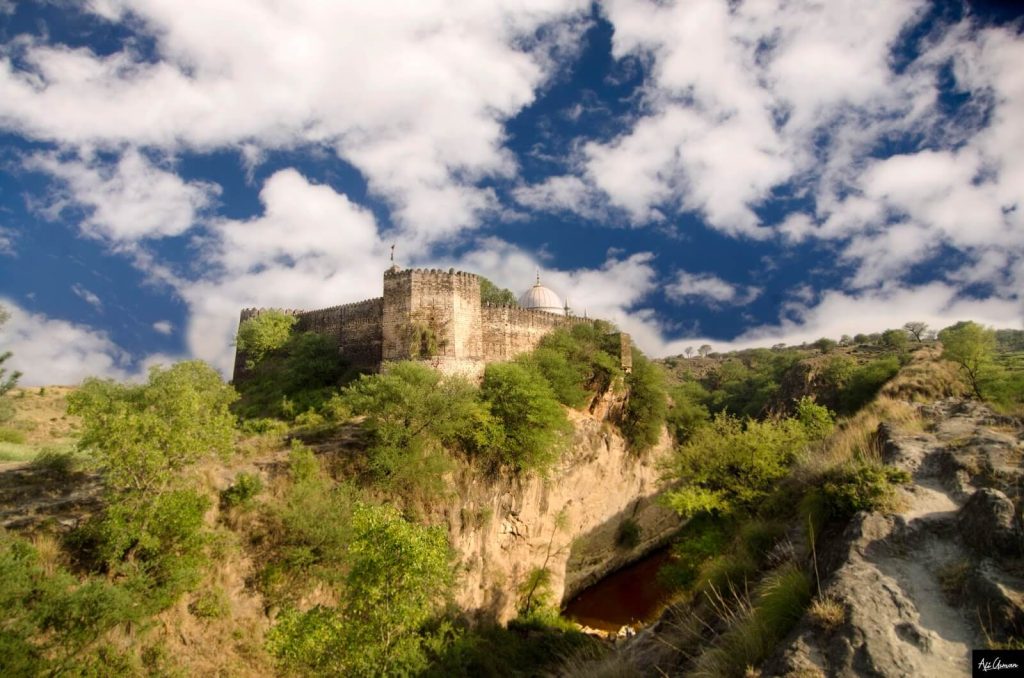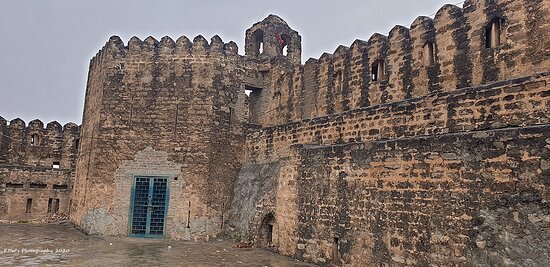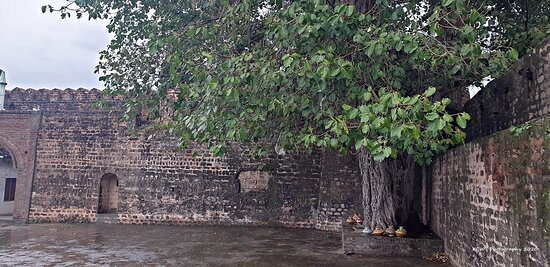Sangni Fort
Rawalpindi Sangni fort is the most splendid and impeccable fort in the Gujar Khan tehsil in Rawalpindi. It reflects different eras and powers which once conquered their enemies and established their rule over the land. Sangni fort is included as one of those places which are not as tremendously reconnoitered or explored as the others. Still, it provides a unique experience to Visitors interested in visiting historical places.
Many fortresses and forts are located near it, including the attack, Pharwala, Rawat, and Giri forts. Nevertheless, the Sangni fort, sitting on an eye-catching spot overlooking two scenic streams, is most breathtaking. So if you are looking forward to a delightful day out, make sure to put Sangni fort on your travel list.
Sangni fort Rawalpindi, attractions, timings, and location
Sangni fort, also called Sangni Kila, is located about 29 km north of Gujjar Khan area of the Potohar plateau, near village Takal in Kallar Syedan tehsil, Rawalpindi district, in Punjab, Pakistan. From Islamabad express highway to the national highway, then from the national highway to the left of Rawat, the land of evergreen fields, Kallar Syedan, is located. You have to Travel through Kallar Syedan road to reach Sangni Fort.
One of the eye-catching features of the Potohar plateau is the arrangement of fortifications spread across the area. It is constructed over the hill from visitors can have an extensive view of various villages, specifically the Sui Cheemian, dhoklas, etc. It opens daily to the public from 9 am to 5 pm and has free entry. A one-and-a-half-hour drive will get you there from Rawalpindi.
History of Sangni Fort Pindi
The history of the Sangni fort remains ambiguous, and there are several theories about who built it and why. Some people believe that it was built by Sikhs when they came to Rawalpindi in the early 19th century to take over Punjab. After the first Anglo-Sikh war, Sikh commander Gulab Singh Dogra took over Kashmir in 1847, and he kept the fort. In contrast, Others think the Mughals built it because of similar architecture to other Mughal strongholds in Rawalpindi. According to some theories, the fort was believed to be used to keep prisoners in the Mughal era.

The Architecture of Sangni Fort Pindi
Rawalpindi Sangni fort is one of the most well-maintained forts of Pakistan, showcasing the art and architecture of old times. The architecture of Sangni fort is a mix of incredible art and traditional styles. There is the use of bricks, arches, and domes in its design. The architecture is divided into two parts – interior and exterior. The exterior of the Sangni Fort Pindi is composed of tall walls, spacious arched entrances, and domed ceilings. However, the interior is more bright and colorful with beautiful paintings. It is built with commendable craftsmanship.
The entrance of Sangni fort is on the southern side, starting with a large door framed by a stylish window. There is a large domed structure above the entrance decorated with colored tiles.
The Diwan-e-Aam (Hall of Public Audience)
Visitors will first come across the hall of the Sangni Fort, known as Diwan-e-Aam. This spacious room has a large rounded entrance and beautifully decorated walls with mirrorwork. In the past, the king used this diwan for the public audience, where the ruler of the fort would address the public and the notable people of the state.
Structure of Sangni fort
Historical records show that the fort was built for defensive purposes and was used to keep prisoners and an eye on the empire’s borders. Its structure consists of towers. The fort has four ramparts with almost equal diameters, with stairs reaching the top of ramparts used in the past to protect the fort and its surrounding region.

Attractions Offered by Sangni Fort Rawalpindi
The first thing you will come across on your way to Sangni fort is a hundred years old banyan (Bargad) tree. While the shade of this tree feels cold, there is astonishment in the mind of those people who view its vast roots and volume. Here are some more attractions.
Perched on a hill
Sangni Fort is perched on a hill overlooking two streams. The original name of the fort was Sangi, but in the era of Ranjit Singh, the name changed from Sangi to Sangni, which possibly means “Meeting point,” relating to the presence of two streams flowing near the fort.
Small lake
The small lake behind the Sangni Fort was used to meet the water needs of the Mughal era.
Panoramic view of several villages
The fort is resting on the top of a hillock; you can have an expansive view of the scenic villages of Sui Cheemian and Dhok Las are located a distance from the fort. Extensive networks of graves can be seen in villages believed to belong to the soldiers in charge of that region for many years. The magnificent dome of Abdul Hakeem’s shrine is observable over the fort ramparts. The shrine’s dome is visible atop, a square structure from the fort’s gate. When you step onto the shrine’s threshold, you will experience a feeling of tranquility.

Abdul Hakeem’s shrine
A beautifully intricate saint’s shrine, Abdul Hakeem, is located in the heart of the Sangni fort. According to the historical facts, saint Abdul Hakeem was of Arab origin, and he migrated to the subcontinent from Iran. He decided to stay there during the conflict between Jammu and Kashmir. When the saint came to Sangni for preaching purposes, he was not allowed to enter by the soldiers, so saint Abdul Hakeem settled in the nearby Chakrali village. During his stay in the village, he preached to many people who became his followers.
Modern ceramics on the wall of the shrine
The shrine is believed to have been built by Abdul Hakeem’s disciples. It is covered by mesmerizing and bright glazed tiles and mirror work, a prominent feature of the shrines in the Potohar plateau. The walls are constructed of marble.
Swimming in lake
On the west of the fort, you can spot an attractive lake. According to followers of Abdul Hakeem, that lake is known as a miracle lake because it miraculously emerged after the saint was buried in the fort. People tend to swim in the lake to rid themselves of evil eyes and illnesses, as water therapy is very significant in this region. It’s one of the few Forts in Pakistan near a lake.
The grave of Abdul Hakeem
After preaching for many years, the saint died in Chakrali village and was buried there. According to the people of the Sangni Fort, some of his followers saw him in their dreams. The saint ordered his followers to shift his grave into Sangni fort, and they did what he told them. His tomb is still in the middle of the Sangni fort, now known as ‘Sangni sharif.’
Sangni fort timing and visiting days
You can visit this historical fort any day of the week between timings of 9 am to 5 pm. But it attracts hundreds of people on Thursdays and Fridays. As it is also used for spiritual practices, newly married people visit a saint’s shrine to pray and hope to get blessings. People also slaughter their animals in the shrine to feed the poor and desire to fulfill their wishes.
Location of Sangni fort
Sangni fort, a fort of the Sikh period, is located near village Takal, about 11km east of lush green fields of Kalar Syedan road, in Rawalpindi district, in Punjab, Pakistan.
Frequently Asked Questions
What is the history of Sangni fort?
The fort was constructed in the Mughal era, between 1823-1825, at the connection of two hill streams. Hence the word Sangni was derivative from the word “Sangam,” meaning the meeting of two creeks.
Who made Sangni fort?
Some believed that it was first built by Mughal emperors as a mud fortress and rebuilt on the instructions of Gulab Singh Dogra, a Hindu governor of the Ranjit Singh era (1801-1839).
Is it worth going to Sangni fort?
Yeah, if you are fond of historical places, this fort is a feast for the eyes and the mind.
Rawalpindi Sangni Fort is a historical landmark. But the Archaeology Dept and locals are at fault for restoring this beautiful fort. You can relax, enjoy the cold wind and watch the sunset. You can also come here with family or friends to spend a day. It is an excellent place to visit both in summer and winter but bring your food because there are no shops nearby.
